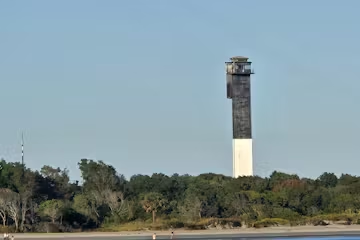Charting to Charleston Light: A Sullivan’s Island Lighthouse Boat Tour
A private, BYOB cruise to Charleston Light—history, dolphins, and Lowcountry views from the best seat on the water.
The boat slips from its lines and noses into Charleston Harbor, where the tide strums the hull like a bass note. Morning light varnishes the water, and the breeze—never content to sit still on the coast—nudges you toward the jetties as pelicans arrow past at eye level. Bottlenose dolphins surface in quick commas, writing their own punctuation mark in the calm. Ahead, the Sullivan’s Island Lighthouse rises like a modernist exclamation, a stark, triangular tower that refuses to play by the rules of quaint coastal nostalgia. This is Charleston Light, and seeing it by water is the most honest introduction you can have.
Trail Wisdom
Time Your Tide
Mornings often offer gentler winds and smoother water; afternoon seabreezes can add chop near the jetties.
Sun Smart on the Water
The reflection off the harbor doubles exposure—pack a wide-brim hat, polarized sunglasses, and reef-safe sunscreen.
Deck-Friendly Footwear
Wear non-marking, grippy soles to keep footing secure on a wet deck and protect the boat.
Respect Wildlife Distance
Admire dolphins and birds without chasing or feeding them; keep voices low and cameras ready.
Local Knowledge
Hidden Gems
- •Backside marsh creeks behind Station 26 for glassy, bird-rich waters on calm days
- •A slow pass near the Sullivan’s Island sandbar at slack tide when surf flattens for clean lighthouse shots
Wildlife
Bottlenose dolphins, Brown pelicans
Conservation Note
Follow no-wake zones, pack out all trash, and maintain at least 50 yards from dolphins to reduce stress on marine mammals.
Charleston Light (1962) is the last major lighthouse built by the U.S. government, standing watch near Fort Moultrie—where a young Edgar Allan Poe served in the 1820s.
Seasonal Guide
spring
Best for: Mild temperatures, Active wildlife
Challenges: Breezy afternoons, Pollen for allergy sufferers
Temperatures are comfortable and the marsh turns vivid; mornings are calm and sightings are frequent.
summer
Best for: Warm water, Long daylight
Challenges: High heat and humidity, Pop-up storms
Plan early or late trips to beat heat and afternoon thunderheads; bring extra water and sun protection.
fall
Best for: Clear skies, Stable weather
Challenges: Occasional tropical systems, Shortening days
Some of the year’s smoothest conditions with crisp light—ideal for photography and longer cruises.
winter
Best for: Quiet waterways, Crisp visibility
Challenges: Cool winds, Fewer departure windows
Bundle up; clear, low-angle light and sparse crowds make for peaceful lighthouse viewing.
Photographer's Notes
What to Bring
Polarized SunglassesEssential
Cuts surface glare to spot dolphins, sandbars, and detail in the lighthouse façade.
Lightweight Windbreaker
Blocks the harbor breeze during runs between the jetties and creeks.
Soft-Sided CoolerEssential
Keeps BYOB drinks and snacks cold while saving deck space.
Telephoto Zoom (70–200mm)
Compresses lighthouse, surf, and wildlife for sharper compositions from the boat.
Common Questions
Can we land at or climb the Sullivan’s Island Lighthouse?
No. The lighthouse is viewed from the water and is not open for climbing; the best vantage is from the boat near the shoreline.
Is the tour family-friendly?
Yes. All ages are welcome; life jackets are provided and mornings are recommended for families seeking calmer water.
What should we bring to eat or drink?
The tour is BYOB—pack a soft cooler with drinks and snacks. Glass is discouraged; cans and reusable bottles travel best.
What happens if the weather turns bad?
Coastal weather can change quickly. The captain monitors conditions and may adjust the route or reschedule to ensure safety.
Will we see dolphins?
Dolphin sightings are common but never guaranteed. The captain maintains a respectful distance to avoid disturbing wildlife.
Where do we meet the boat?
Departures are from the Charleston area; exact marina details are provided in your confirmation after booking.
What to Pack
Polarized sunglasses for glare; reef-safe sunscreen and a hat for all-day sun; soft cooler with water and snacks (BYOB allowed); light windbreaker for breezy runs between the jetties and creeks.
Did You Know
Charleston Light on Sullivan’s Island, completed in 1962, was the last major lighthouse built by the U.S. federal government and originally featured an elevator and air conditioning.
Quick Travel Tips
Book morning departures for smoother water and better wildlife viewing; use rideshare or arrive early to find marina parking; bring non-marking shoes to protect the deck; confirm departure point and weather window the evening before.
Local Flavor
Post-cruise, refuel at Poe’s Tavern on Sullivan’s Island for a nod to The Gold-Bug, or head to The Obstinate Daughter for coastal Italian with a Lowcountry accent. Prefer dockside? Shem Creek in Mount Pleasant serves sunset with your shrimp and grits—try Red’s Ice House or Water’s Edge for casual waterfront views.
Logistics Snapshot
Closest airport: Charleston International (CHS), ~20 minutes from downtown. Launch points vary around Charleston; expect a 15–25 minute drive from the historic district. Cell service is generally strong near the harbor. No permits required for guests; BYOB is allowed—use cans/reusables and pack out all trash.
Sustainability Note
This estuary is a nursery for marine life—skip single-use plastics, keep 50 yards from dolphins, idle through no-wake zones, and never toss food scraps or fishing line overboard.
